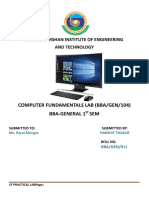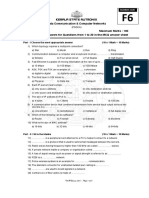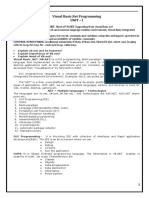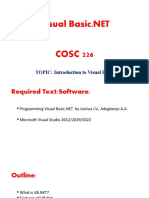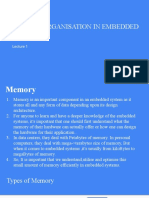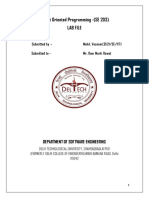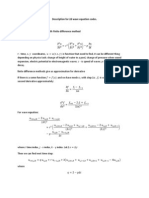Professional Documents
Culture Documents
Ethernet Layer 2, Switching and Bridging Logic Lec2
Ethernet Layer 2, Switching and Bridging Logic Lec2
Uploaded by
Hiroyo Chan0 ratings0% found this document useful (0 votes)
48 views15 pagesThe document discusses Ethernet frames and packets. It defines frames as containing a Layer 2 header and trailer encapsulating data, while packets contain only a Layer 3 header and data. Ethernet specifications relate to creating, forwarding, receiving, and interpreting frames. It also describes the standardization of Ethernet, frame formats, address types, frame transmission methods, switch learning, and IP multicast applications using multicast addresses.
Original Description:
Ethernet Layer 2, Switching and Bridging Logic lecture2
Original Title
Ethernet Layer 2, Switching and Bridging Logic lec2
Copyright
© © All Rights Reserved
Available Formats
PDF, TXT or read online from Scribd
Share this document
Did you find this document useful?
Is this content inappropriate?
Report this DocumentThe document discusses Ethernet frames and packets. It defines frames as containing a Layer 2 header and trailer encapsulating data, while packets contain only a Layer 3 header and data. Ethernet specifications relate to creating, forwarding, receiving, and interpreting frames. It also describes the standardization of Ethernet, frame formats, address types, frame transmission methods, switch learning, and IP multicast applications using multicast addresses.
Copyright:
© All Rights Reserved
Available Formats
Download as PDF, TXT or read online from Scribd
Download as pdf or txt
0 ratings0% found this document useful (0 votes)
48 views15 pagesEthernet Layer 2, Switching and Bridging Logic Lec2
Ethernet Layer 2, Switching and Bridging Logic Lec2
Uploaded by
Hiroyo ChanThe document discusses Ethernet frames and packets. It defines frames as containing a Layer 2 header and trailer encapsulating data, while packets contain only a Layer 3 header and data. Ethernet specifications relate to creating, forwarding, receiving, and interpreting frames. It also describes the standardization of Ethernet, frame formats, address types, frame transmission methods, switch learning, and IP multicast applications using multicast addresses.
Copyright:
© All Rights Reserved
Available Formats
Download as PDF, TXT or read online from Scribd
Download as pdf or txt
You are on page 1of 15
The word frame refers to the bits and bytes that
include the Layer 2 header and trailer, along
with the data encapsulated by that header and
trailer. The term packet is most often used to
describe the Layer 3 header and data, without a
Layer2 header or trailer. Ethernet’s Layer 2
specifications relate to the creation, forwarding,
reception and interpretation of Ethernet frames.
The original Ethernet specifications were owned
by the combination of Digital Equipment Corp,
Intel, and Xerox—hence the name ―Ethernet
(DIX).‖
Later, in the early 1980s, the IEEE standardized
Ethernet, defining parts (Layer 1 and some of
Layer 2) in the 802.3 Media Access Control (MAC)
standard, and other parts of Layer 2 in the 802.2
Logical Link Control (LLC) standard.
Later, the IEEE realized that the 1-byte DSAP field
in the 802.2 LLC header was too small. As a
result, the IEEE introduced a new frame format
with a Sub-Network Access Protocol (SNAP)
header after the 802.2 header, as shown in the
third style of header.
Finally, in 1997, the IEEE added the original DIX
V2 framing to the 802.3 standard.
Ethernet addresses, also frequently called
MAC addresses, are 6 bytes in length,
typically listed in hexadecimal form. There
are three main types of Ethernet address.
- Unicast
- Broadcast
- Multicast
When an Ethernet NIC needs to send a frame,
it puts its own unicast address in the Source
Address field of the header.
If it wants to send the frame to a particular
device on the LAN, the sender puts the other
device’s MAC address in the Ethernet
header’s Destination Address field.
If the sender wants to send the frame to every
device on the LAN, it sends the frame to the
FFFF.FFFF.FFFF broadcast destination address.
A frame sent to the broadcast address is
named a broadcast or broadcast frame, and
frames sent to unicast MAC addresses are
called unicasts or unicast frames.
Multicast Ethernet frames are used to
communicate with a possibly dynamic subset of
the devices on a LAN.
The most common use for Ethernet multicast
addresses involves the use of IP multicast.
For example, if only 3 of 100 users on a LAN want
to watch the same video stream using an IP
multicast–based video application, the application
can send a single multicast frame. The three
interested devices prepare by listening for frames
sent to a particular multicast Ethernet address,
processing frames destined for that address.
Other devices may receive the frame, but they
ignore its contents.
For unicast forwarding to work most
efficiently, switches need to know about all
the unicast MAC addresses and out which
interface the switch should forward frames
sent to each MAC address.
Switches learn MAC addresses, and the port
to associate with them, by reading the source
MAC address of received frames.
Reference:
Textbook: CCIE routing and switching certification
guide (4th edition) by wendell odom, Rus Healy,
Denise Donohue.
You might also like
- CompTIA Security+ SY0-501 Exam (Valid 88 Questions & Answers) 2017Document7 pagesCompTIA Security+ SY0-501 Exam (Valid 88 Questions & Answers) 2017SY0-501 Dumps50% (10)
- Lecture Notes On Computer and Data Security: by Dr. Samaher Hussein AliDocument5 pagesLecture Notes On Computer and Data Security: by Dr. Samaher Hussein Alisamaher husseinNo ratings yet
- Computer Fundamentals Lab FileDocument27 pagesComputer Fundamentals Lab FileNischay DhimanNo ratings yet
- Data Structure MCQ (Multiple Choice Questions) - SanfoundryDocument15 pagesData Structure MCQ (Multiple Choice Questions) - SanfoundryEzekiel JamesNo ratings yet
- Exercise 101 For Students Enrolled in Joomla CourseDocument4 pagesExercise 101 For Students Enrolled in Joomla CourseJoel Fagsao100% (1)
- Ip Lab Manual CS6512 PDFDocument53 pagesIp Lab Manual CS6512 PDFgopivrajan29% (7)
- F6 - Data CommunicationDocument2 pagesF6 - Data CommunicationAkash ReghuNo ratings yet
- 2082 - Unit 4 Notes WT (BCA 204)Document26 pages2082 - Unit 4 Notes WT (BCA 204)DhananjayKumarNo ratings yet
- Data Structures and Algorithms: Module - 3 Linked ListDocument44 pagesData Structures and Algorithms: Module - 3 Linked Listbhumika.verma00No ratings yet
- Lab Manual Soft Computing IT - 701Document60 pagesLab Manual Soft Computing IT - 701Devendra Singh KaushalNo ratings yet
- Cloud Computing Lab ManualDocument79 pagesCloud Computing Lab Manualsasirekhar.aidsNo ratings yet
- Ijisrt Paper TempDocument3 pagesIjisrt Paper TempmahedreNo ratings yet
- Question Bank System Analysis and Design MCA 205Document5 pagesQuestion Bank System Analysis and Design MCA 205Aftab KhanNo ratings yet
- E Com LabDocument42 pagesE Com Labnishita grover100% (1)
- Bca-Vi Sem-Pc HW and Network-SylDocument6 pagesBca-Vi Sem-Pc HW and Network-Syllo leeeNo ratings yet
- Analog Communication Previous PaperDocument7 pagesAnalog Communication Previous PaperrachelNo ratings yet
- Anna University OOPS Question Bank Unit 2Document6 pagesAnna University OOPS Question Bank Unit 2Karthic SundaramNo ratings yet
- Office Automation Tools - SyllabusDocument2 pagesOffice Automation Tools - SyllabusYUVASHAKTHI COMPUTERSNo ratings yet
- OOPC 1 Research AssignmentDocument4 pagesOOPC 1 Research Assignmentdileepa nuwanNo ratings yet
- LAB-Final Assessment Test: InstructionsDocument7 pagesLAB-Final Assessment Test: InstructionsMajety S LskshmiNo ratings yet
- Object Oriented Programming in C++Document4 pagesObject Oriented Programming in C++Subas ShresthaNo ratings yet
- Copa MCQ PythonDocument14 pagesCopa MCQ PythonVishwanath ITINo ratings yet
- MS Dos AssignmentDocument4 pagesMS Dos AssignmentAfrozNo ratings yet
- Computer Network Practical FileDocument31 pagesComputer Network Practical FileAbhishek JainNo ratings yet
- Java Lab ManualDocument48 pagesJava Lab Manualkhanimran182No ratings yet
- Cloud Computing Quiz 1Document2 pagesCloud Computing Quiz 1DiamondNo ratings yet
- CNS-Super Important questions-18CS52Document3 pagesCNS-Super Important questions-18CS521JS19CS188 Vijay NaikNo ratings yet
- Macro ProcessorDocument44 pagesMacro ProcessorDanielLuci100% (1)
- Flowcharts Lesson With AnswersDocument18 pagesFlowcharts Lesson With AnswersAmos DakaNo ratings yet
- VB NET Short NotesDocument11 pagesVB NET Short NotesAbody 7337No ratings yet
- Applet:: Java Programming UNIT-5Document11 pagesApplet:: Java Programming UNIT-5uddagiri sirishaNo ratings yet
- VB Net Unit IDocument25 pagesVB Net Unit Ishamalu2011100% (1)
- IT8501 NotesDocument215 pagesIT8501 NotesNobitaNo ratings yet
- BCA 307 Web Designing Lab Practical ListDocument1 pageBCA 307 Web Designing Lab Practical ListKirti GargNo ratings yet
- 18CS42 Model Question Paper - 1 With Effect From 2019-20 (CBCS Scheme)Document3 pages18CS42 Model Question Paper - 1 With Effect From 2019-20 (CBCS Scheme)M.A rajaNo ratings yet
- Mca-20-14 Kuk Mca Computer Network PaperDocument3 pagesMca-20-14 Kuk Mca Computer Network PapergauravNo ratings yet
- Unit-4 Question BankDocument3 pagesUnit-4 Question BankDeepakNo ratings yet
- Notes - Assembler DirectivesDocument23 pagesNotes - Assembler DirectivesghangaleNo ratings yet
- WP Lab ObservationDocument34 pagesWP Lab ObservationDëváNo ratings yet
- Os Lab - Terminal Exam - Spring 2021Document4 pagesOs Lab - Terminal Exam - Spring 2021Maaz Chauhann100% (1)
- Assignment Bca DBMSDocument13 pagesAssignment Bca DBMSbinalamitNo ratings yet
- Designing Interface and DialogueDocument16 pagesDesigning Interface and DialogueAmirah Diyana50% (2)
- Introduction To VB - Net 2Document84 pagesIntroduction To VB - Net 2Chiamaka AnyanwuNo ratings yet
- MAD Android LAb Manual Chapter 3Document4 pagesMAD Android LAb Manual Chapter 3علی احمدNo ratings yet
- Hbase PPT PDFDocument100 pagesHbase PPT PDFAnupam BaruahNo ratings yet
- Layers of NetscapeDocument4 pagesLayers of NetscapeSunil NagarNo ratings yet
- BCA 6TH Sem Artificial IntelligenceDocument2 pagesBCA 6TH Sem Artificial IntelligenceShravani SalunkheNo ratings yet
- Question PaperDocument8 pagesQuestion PaperGopi PNo ratings yet
- CG Monitors WorkstationDocument14 pagesCG Monitors WorkstationAmbika JaiswalNo ratings yet
- Question One 1. Discuss The Roles of Os in Device ManagementDocument11 pagesQuestion One 1. Discuss The Roles of Os in Device ManagementPie ZedNo ratings yet
- Memory Organisation in Embedded SystemsDocument12 pagesMemory Organisation in Embedded SystemsUthra SowrirajanNo ratings yet
- Fundamentals of Data Science Lab Manual New1Document32 pagesFundamentals of Data Science Lab Manual New1Shamilie MNo ratings yet
- CS2354 Advanced Computer Architecture Anna University Question Paper For MEDocument2 pagesCS2354 Advanced Computer Architecture Anna University Question Paper For MEpraveenaprabhuNo ratings yet
- Oops Lab VaseemDocument41 pagesOops Lab VaseemMohd. VaseemNo ratings yet
- Cps Module 3Document27 pagesCps Module 3Radhika AjadkaNo ratings yet
- OS Assignment#1 Spring2020 PDFDocument4 pagesOS Assignment#1 Spring2020 PDFUsamaNo ratings yet
- CC QTN PaperDocument2 pagesCC QTN Paperbalaanand_mcaNo ratings yet
- Matlab File - Deepak - Yadav - Bca - 4TH - Sem - A50504819015Document59 pagesMatlab File - Deepak - Yadav - Bca - 4TH - Sem - A50504819015its me Deepak yadavNo ratings yet
- Network Management System A Complete Guide - 2020 EditionFrom EverandNetwork Management System A Complete Guide - 2020 EditionRating: 5 out of 5 stars5/5 (1)
- ContractsDocument4 pagesContractsHiroyo ChanNo ratings yet
- What Is A Business StructureDocument7 pagesWhat Is A Business StructureHiroyo ChanNo ratings yet
- SPAN and RSPANDocument15 pagesSPAN and RSPANHiroyo Chan0% (1)
- Virtual LANsDocument12 pagesVirtual LANsHiroyo ChanNo ratings yet
- Train ScheduleDocument7 pagesTrain Scheduledoob10163No ratings yet
- Thesis Opponent QuestionsDocument4 pagesThesis Opponent QuestionsMonique Anderson100% (2)
- D Link Gold CCTV CABLE SPECIFICATIONSDocument2 pagesD Link Gold CCTV CABLE SPECIFICATIONSShiva ShankarNo ratings yet
- KTC Silabus Dan JadwalDocument4 pagesKTC Silabus Dan JadwalAgil AmbardiNo ratings yet
- Plastcon - Platic Waste Converted Into A Resource - The Process Explained - Flowdiagram With Pie ChartDocument1 pagePlastcon - Platic Waste Converted Into A Resource - The Process Explained - Flowdiagram With Pie Chart2K19/PS/023 DEEPANSHU DAGARNo ratings yet
- Thermobreak TIB - Noise Attenuation of DuctworkDocument9 pagesThermobreak TIB - Noise Attenuation of DuctworkbinhjukiNo ratings yet
- A Failure of Focus - KodakDocument30 pagesA Failure of Focus - KodakchangumanguNo ratings yet
- Segmentation, Targeting, and Positioning - Consumer Behavior PDFDocument4 pagesSegmentation, Targeting, and Positioning - Consumer Behavior PDFHi GNo ratings yet
- 0 - FB UFM V5 (TwinCat 2 Und 3) - ENDocument40 pages0 - FB UFM V5 (TwinCat 2 Und 3) - ENJosé Titla CosmeNo ratings yet
- 2017 Automation Alley Technology Industry ReportDocument15 pages2017 Automation Alley Technology Industry ReportMark CavittNo ratings yet
- Description For 2d Wave Equation CodesDocument7 pagesDescription For 2d Wave Equation CodesJoe BonfieldNo ratings yet
- Viruses and Prokaryotes: Colonies of E. Coli BacteriaDocument28 pagesViruses and Prokaryotes: Colonies of E. Coli BacteriaMario Alberto Mora OrtizNo ratings yet
- UMPM98: IEC 870-5-101 Multi-Point Traffic MASTER StatkraftDocument96 pagesUMPM98: IEC 870-5-101 Multi-Point Traffic MASTER StatkraftwaltdisneyyNo ratings yet
- ENAT Class Grade 7 PostTestDocument50 pagesENAT Class Grade 7 PostTestRex San GabrielNo ratings yet
- Linking With The 4th Dimension - Chapter 13 - The Great White BrotherhoodDocument8 pagesLinking With The 4th Dimension - Chapter 13 - The Great White BrotherhoodMr. Me100% (1)
- The ICT Lounge: Computer VirusesDocument3 pagesThe ICT Lounge: Computer VirusesJedediah PhiriNo ratings yet
- Meyer Fortes - The Structure of Unilineal Descent GroupsDocument25 pagesMeyer Fortes - The Structure of Unilineal Descent GroupsMarcelo CamargoNo ratings yet
- Next-GEN Digital Stack For Student Management: Wip - Si6 ConfidentialDocument2 pagesNext-GEN Digital Stack For Student Management: Wip - Si6 ConfidentialVijay ReddyNo ratings yet
- Barriers in International BusinessDocument8 pagesBarriers in International BusinessNishtha SethNo ratings yet
- High Precision Dual Frequency RTK Board Instructions For UseDocument10 pagesHigh Precision Dual Frequency RTK Board Instructions For UseMishra dtuNo ratings yet
- Gaugamela PlutarchDocument15 pagesGaugamela PlutarchFreddie AguirreNo ratings yet
- CE364 Chapter 2Document23 pagesCE364 Chapter 2عبدالرحمن الحازميNo ratings yet
- Math For MatricDocument8 pagesMath For MatricFara DibaNo ratings yet
- Clive Barker's Undying - Guía Del JuegoDocument4 pagesClive Barker's Undying - Guía Del JuegoPETARDACANo ratings yet
- Erika's ResumeDocument2 pagesErika's ResumeelbaranekNo ratings yet
- DebussyDocument6 pagesDebussyapi-3743066100% (2)
- Microsoft Word - Proctor TranscriptDocument107 pagesMicrosoft Word - Proctor TranscriptMays BagsNo ratings yet
- What Is A SAN: UC434S G.00Document33 pagesWhat Is A SAN: UC434S G.00Amin JafariNo ratings yet
- Alcoa Ultralloy® 6020-T8 Aluminum: Metal, Nonferrous Metal, Aluminum Alloy, 6000 Series Aluminum AlloyDocument2 pagesAlcoa Ultralloy® 6020-T8 Aluminum: Metal, Nonferrous Metal, Aluminum Alloy, 6000 Series Aluminum AlloyChristina Christina ChristinaNo ratings yet


